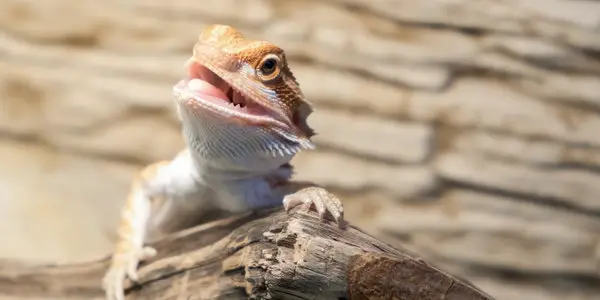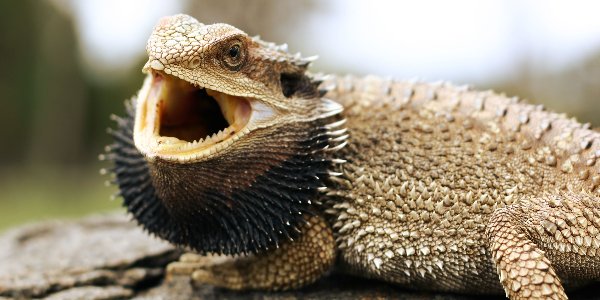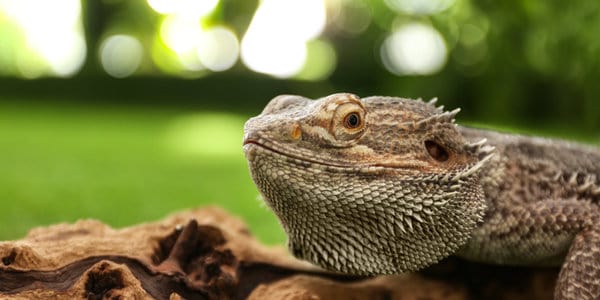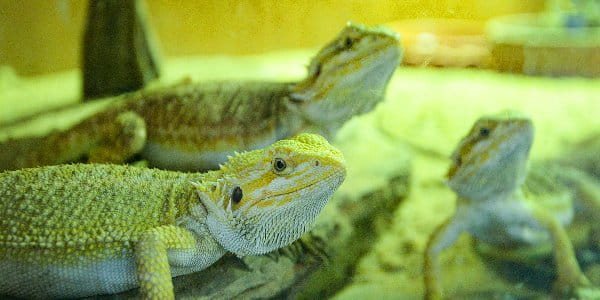Bearded dragons are hardy pets but are still susceptible to mouth problems. Mouth rot or crusty mouth, otherwise known as infectious stomatitis, is these lizards’ most rampant oral disease. It affects the bearded dragon’s jawbone and gums. The disease can affect both captive and wild beardies.
Severe mouth disease can be fatal for a bearded dragon. Therefore, it is essential to know the causes, signs, tips on prevention, and available treatment measures to ensure that you give your pet a quality life in captivity. Let us have a look at these and much more below.

What Is Mouth Rot?
Mouth rot is a condition that affects a bearded dragon’s jawbone and gums. Even so, it is not specific to bearded dragons and affects other reptiles as well. It can be fungal, viral, or bacterial. When a bearded dragon suffers from this mouth disease, it can be very uncomfortable and often affects the lizard’s eating habits.
What Causes Mouth Rot In Bearded Dragons?
The condition arises from various issues. However, a weak immune system significantly contributes to your bearded dragon developing mouth rot. Suppressed immunity leads to the multiplication of bacteria inside the pet’s mouth, causing mouth infection.
Your pet bearded dragon could suffer suppressed immunity for various reasons such as poor hygiene in the habitat, parasitic infections, inappropriate humidity, wrong temperature, and improper diet. Mouth injuries from trauma, biting sharp things, improper handling, etc., can also lead to moth rot in your pet.
Stress is another cause of suppressed immunity in bearded dragons. Stress factors make the pet uncomfortable, which contributes to a weakening immune system.
Bearded dragon mouth problems can also occur when the mouth has tears from food or food is stuck in the pet’s teeth. Accumulating the food remnant leads to bacterial multiplication and buildup, which contributes to mouth rot.
Signs Of Mouth Rot In Bearded Dragons
Early detection of mouth rot is quite vital. When neglected or unidentified, it can affect the entire mouth and even spread to other body parts such as the lungs and esophagus, making treatment even more complicated. As such, it is crucial to know the signs to look for and facilitate early treatment.
1. Loss of Appetite and Bloating
One of the key indicators that all is not well with a beardie is a change in their eating habits. A bearded dragon suffering from mouth rot will eat less due to a lack of appetite. Eating becomes an uncomfortable experience for the pet due to the state of their mouth.
Poor appetite might be accompanied by bloating. As much as the pet eats less than usual, they tend to suffer from bloating when they have a mouth rot infection. Bloating can be pretty uncomfortable for a bearded dragon making it to avoid eating further.
2. Oral Patches
A key indicator of a bearded dragon’s mouth rot is whitish-grey or yellowish-grey patches in the mouth. Inspect its mouth cavity, and if the pet is suffering from mouth rot, you are likely to notice tiny patches of these colors.
Oral patches are an ultimate sign that your bearded dragon has mouth rot and are not a common symptom in other bearded dragon diseases.
3. Teeth Loss
Bearded dragons have teeth, and while some regrow once lost, others don’t, so you should protect your pet beardie from teeth loss.
In extreme cases of mouth rot, your bearded dragon’s teeth will start growing loose, making them fall off. When you notice teeth loss in your bearded dragon, treat it as an emergency and rush the pet to an exotic vet for immediate examination and treatment.
4. Hemorrhage of Gums
Seeing your bearded dragon’s blood in its mouth can be pretty scary, and we agree it is not normal. It is often a sign of mouth rot, and the blood results from bleeding gums. Bearded dragon blood in mouth usually occurs in advanced cases, and you should take your pet to the vet immediately when you notice this.
5. Other Signs
The other signs of mouth rot in bearded dragons include excess thick mucus, gum swelling, reduced water intake, thick saliva, and swollen head. Most of these manifest in advanced illnesses.

How to Treat Mouth Rot In Bearded Dragons?
Home Remedies
Before starting, it is worth noting that the bearded dragon mouth rot home remedy is only suitable and ideal if the illness has just begun. It involves using a disinfectant such as Nolvasan or an antiseptic such as Betadine, which are both safe for a bearded dragon.
Mix your solution of choice with water in a large cup and stir until the mixture is consistent. Use a cotton piece to apply the solution to the pet’s infected areas all around the mouth. It might be uncomfortable for the bearded dragon, so you should be gentle. If your pet becomes aggressive, stop and allow it time to rest before trying again.
Rinse off the solution using a soft cloth and clean water. Where possible, remove any tartar or plaque buildup in the beardie’s mouth. Repeat this daily; if effective, you should notice improvement within a few days. Where the mouth rot is not disappearing, take the beardie to an exotic vet for further diagnosis.
Consult a Vet
Consulting a professional is the best solution for a bearded dragon’s mouth rot and any other illness. An exotic vet has the knowledge and expertise to correctly diagnose, treat and propose preventive measures for the illness.
The vet will perform an intense oral physical exam on the bearded dragon. The treatment of choice will depend on the extent of the illness varying from antibiotics to surgery. Thorough cleaning of the affected areas will accompany antibiotic treatment for mild to moderate cases.
Surgery might be the most feasible solution in severe cases as the vet would need to remove the highly damaged oral tissues. Your bearded dragon might not be able to eat during recovery post-surgery and might instead require food support and food therapy for them to resume normal eating.
How To Prevent Mouth Rot In Bearded Dragons?
Treating mouth rot in bearded dragons can be quite expensive in terms of time and money. It is also a non-pleasant experience for your pet. Thus, it would be best to put measures in place to prevent mouth rot infection. Here are helpful tips to avoid mouth rot in bearded dragons.
1. Proper Diet
The best way to prevent mouth rot and other illnesses in bearded dragons is by giving the pet a proper diet per its age. An ideal diet promotes the pet’s overall immunity, which is vital in preventing mouth rot.
Proper diet varies depending on the pet’s age. Thus, you should find a suitable feeding schedule that is specific to your bearded dragon’s needs.
Juvenile bearded dragon mouth rot is more common and often arises from a poor diet because these young reptiles are more vulnerable.
2. Remove Stress Factors
Stress factors in a bearded dragon’s environment lead to suppressed immunity. Therefore, you should ensure to provide a big enough tank, suitable basking temperature for both the basking and resting area, ideal humidity, a clean environment, and appropriate toys.
A non-stressed bearded dragon will likely remain in optimal health, which means that its immunity will also thrive.
3. Annual Checkups
Bearded dragons do not require frequent checkups as much as dogs and cats. Even so, it is good to schedule annual examinations for the beardie where the vet will perform a comprehensive medical examination. It will help detect mouth rot early and other illnesses and mineral and vitamin deficiencies.
Ask the vet to guide you on how to open the pet’s mouth for regular inspections at home. Not doing this correctly can break the pet’s jaw break or suffer long-term damage.

Frequently Asked Questions
What Are the Juvenile Bearded Dragon Mouth Rot Signs?
Juvenile bearded dragon mouth rot signs are no different from those in adults. Both include yellow-grayish or white grayish patches, poor feeding, blood in the mouth, and teeth loss, with the latter two signs being for severe cases.
How Do Your Treat Reptile Mouth Rot?
The method of treating reptile mouth rot depends on the extent of the illness. Your vet might recommend antibiotics and cleaning the animal’s mouth if the cases are mild or moderate.
Severe cases sometimes require surgery which would require extensive care and monitoring for the pet to resume normalcy.
How Did My Bearded Dragon Get Mouth Rot?
This infection often arises from bacterial buildup in the mouth or suppressed immunity. Some factors contribute to these causes, such as food remnants being stuck in the teeth, poor hygrine, improper diet, poor temperature, etc.
Examine your pet’s feeding and living conditions to see which could be the ultimate cause of mouth rot in your bearded dragon.

Conclusion
To detect bearded dragon mouth problems early, you must monitor the pet closely. Bonding with your lizard will make it easier for you to inspect its mouth, etc. Mouth rot affects beardies mainly due to suppressed immunity that can arise for various reasons.
Be on the lookout for bearded dragon oral rot signs such as patches in the mouth, bleeding gums, and loss of appetite. Vet diagnosis and treatment is the most effective and suitable solution for mouth rot in bearded dragons.